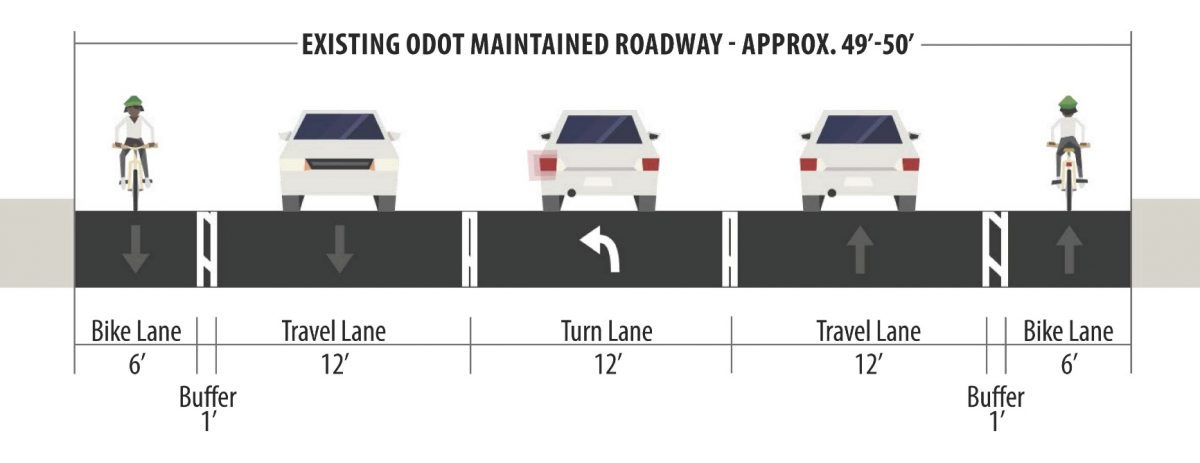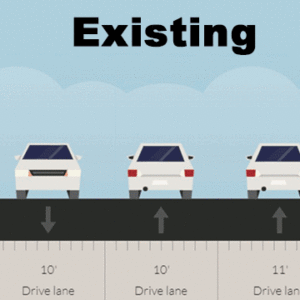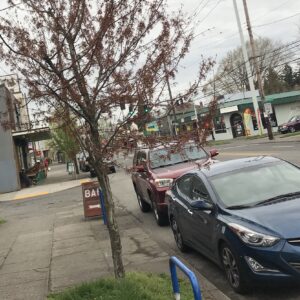
(Graphic: ODOT)
The Oregon Department of Transportation has begun construction on a project that will significantly redesign a 1.2-mile stretch of North Lombard. The $16.5 million Lombard Multimodal Safety Project will re-stripe traffic lanes, repave the badly deteriorated street, upgrade signals, add more robust crossings, and stripe unprotected buffered bike lanes between N Huron and N Boston. The project will include new median islands and flashing beacons at N Emerald and Delaware.
Advertisement


The changes are a result of ODOT wanting to improve safety and freight movement reliability. According to state data, Lombard is the 11th highest crash corridor in the city of Portland with a crash occurring every 9 days on average. The existing cross-section has five lanes; two general travel lanes in each direction and one auto parking lane. The new configuration will add two dedicated bike lanes and a center turn lane. The two general travel lanes will be widened from 10.5 to 12 feet in order to facilitate large trucks (Lombard is US30 Bypass and a major ODOT freight route).
ODOT opened an online open house and comment opportunity today that will be available through January 31st.
While work has begun on the project, the repaving and re-striping won’t begin until spring of next year. ODOT says the new buffered bike lanes should be finished by summer 2022.
— Jonathan Maus: (503) 706-8804, @jonathan_maus on Twitter and jonathan@bikeportland.org
— Get our headlines delivered to your inbox.
— Support this independent community media outlet with a one-time contribution or monthly subscription.






Thanks for reading.
BikePortland has served this community with independent community journalism since 2005. We rely on subscriptions from readers like you to survive. Your financial support is vital in keeping this valuable resource alive and well.
Please subscribe today to strengthen and expand our work.
Overall this is certainly better than the status quo, and with the restricted street width available I can live with what is presented.
However, I wish that ODOT and PBOT would work together to try to divert all freight traffic to the parallel Columbia Blvd and Marine Drive instead of Lombard; they’re much better-suited for freight and don’t run right through the middle of neighborhoods. I can’t imagine that either of those roads would become over-capacity as a result. That would allow for the narrowing of the lanes to 10-ft widths and hence the possibility of adding actual protection for the bike lanes, not just a single-foot buffer.
In what world does a semi truck need 12′? Semis are, at the very widest, 8.5-9′. That’s 36′ of car space for 27 feet of truck max. Let’s not assume ODOT has any interest in the people living in neighborhood. The purpose of the design is to maintain speed, not to provide safe infrastructure.
I can’t claim to know much about that topic so take everything I say in this comment with a grain of salt, but I’d certainly hope that there’d be at least one foot of space on each side of the widest semis. Otherwise I’d assume ODOT would open up themselves to the inevitable negligent design lawsuit when a semi driver slightly out of position in their lane crashes into someone in the center turn lane. So that means that at least 11 feet would probably be necessary. But I do agree that the center turn lane should be narrowed to 10 feet at the very least, giving an additional foot of space for the buffer.
And I try not to assume motive without evidence, and I see no evidence either way regarding ODOT’s motive here beyond their desire for safety they include in their document.
Here are the maximum width requirements set at 8.5′.
I agree assuming motive without evidence is a good rule of thumb. Looking at precedent gives us clues on how we might view the design. ODOT typically uses 12′ lanes for their projects which are primarily hiways. ODOT often designs hiways for fast (50mph+) straight, travel. In general, the wider the lane, the faster the traffic. Using the same design standards as, for example, on a neighborhood street such as Lombard will predictably result in death and injury. 12′ lanes precludes any physical barrier, which reduces the cost. So ODOT can call this a multimodal project, while not actually providing any substantive safety in its design. It is depressing to think that safety advocates who look at this design see anything but death and injury.
It’s not clear that even removing semi trucks from Lombard would change ODOT’s standard 12′ lane design.
Cyclists are only 2′ wide…why do they need 6′ lanes?
Bike lanes in the UK are frequently only 2 feet wide. On the other hand, car lanes are much narrower there.
Drivers are possibly slightly wider, so let’s make driving lanes 3′?
Some cargo bikes are over 43” wide.
I think this is much needed, however, I would prefer that the state legislature take a long, hard look at freight traffic in N Portland and find a way to move as much of it as possible away from residential streets, prioritizing moving freight along N Marine Drive to the greatest extent possible. The legislature should also consider a new Willamette River crossing so that freight traffic is not using St Johns Bridge, unless they are delivering to St Johns neighborhood businesses.
I’m glad for these transportation improvements for Arbor Lodge, Kenton, and surrounding North Portland neighborhoods. If you are, too, please respond to the survey on the project page, to ensure that the cars-only crowd don’t manage to yank back some of the improvements at the last second, like they did to the bike lane on N. Denver into Kenton.
Jonathan, it’s a shame that this upgrade stops one block short of the bike lane on N. Denver. Do you have any ideas for how we might be able to get ODOT to complete the link (from Boston to Denver) as part of this project?
Yes that is a shame Mark. Looks like it’s more like 3 blocks and I suspect this has something to do with budget. I’ll see what I can find out.
We really need to listen to this quote above. The OTA aka Jana Jarvais really wanted improvements on Lombard. This is a significant improvement for both truck and freight. However, we should not let anything go forward without a protected bike lane. The wavy gravy nature of this pattern means uncareful truckers will drift into the bike lane just because it’s there. All freight traffic at I-5 should be diverted to other ramp access points. Protected bike lanes are a must. There is no question who would die in another freight accident. Furthermore all freight should be diverted as suggested above. I’m too far away to make further suggestions, but no way Jose without built protected bike lanes. This aint a rodeo.
I like the idea median islands on Lombard but I do not see why it needs to have bike lanes. There are plenty of side streets that parallel Lombard we bikers can use. Even with the road enhancements, Lombard will still be a sketch to ride on.
Bike lanes like these are not really designed for bikes, but rather to keep cars and trucks on the strongest center part of the roadway bed and away from its weakest but most expensive parts, the curb and gutter.
I don’t know why we have to make Lombard easy for trucks to use. Columbia parallels it just a few blocks to the north… or trucks could bypass the area entirely by taking Hwy 30 to I-84 and avoid Lombard completely.
Yeah this is an issue all parties are aware of. Problem afaik is Columbia has some overpasses that can’t handle large trucks/loads. Once those are fixed, we can push for switch.
Do you know which overpasses and how long that will take?
Agree. No one is going to ride this stretch of Lombard. It doesn’t connect to anything and provides no actual protection. I’d much rather see ultra-wide sidewalks with space for benches and outdoor seating at businesses.
Lombard in NoPo is changing rapidly. The dense buildings going up are awesome but the added density will not work as long as Lombard is treated like an actual highway.
Lets be honest about who they’re catering to… “The two general travel lanes will be widened from 10.5 to 12 feet in order to facilitate large trucks.” This is clearly for the next generation of huge pickup truck commuter vehicles that will be semi truck sized. Plus you need that buffer for swerving down the road as you stare at your infotainment system.
1″ marked with paint counts as “buffered”? We need to change the official definitions of misused words.
This is a welcome change that will make a huge difference. What I don’t get is the obsession so many people have with trucks. How many of you actually ride Lombard?
Lombard is a bad road to ride on, but that has nothing to do with trucks (of which there aren’t many). It’s because cars go fast, they constantly switch lanes to avoid left turning vehicles and stopping buses and you’re butted up against a curb with zero shoulder.
The new configuration basically eliminates passing which is going to slow things way down and make traffic move way more predictably. People will enter turn lanes to pass buses and slow right turning vehicles, but it’s still going to be a big improvement.
Trucks are a good thing on roads like this as they serve a traffic calming function. They aren’t nearly as erratic in their movements as cars and they slow and speed up much more gradually. In any case, how do you think they’re going to get stuff to businesses without them?
I expect to see only a few cyclists on it when complete. Lombard is a garbage road from a riding perspective. The new config won’t change that it’s noisy, busy, and those who fear traffic will still experience issues with hooks and vehicles pulling out as there is a lot of turning — i.e. they’re better off on the side roads.
The big win here is that it’s going to slow the traffic way down and things safer and more predictable. Hopefully, it won’t cause long tailbacks because that will only push traffic onto neighborhood streets
At least for me, I’m fine with the truck drivers themselves; I’ve found that professional semi drivers are usually pretty good at following the rules of the road and being respectful to others. The only reason I wish that through trucks (i.e. those coming from the St. Johns Bridge or the industrial areas to the west and going straight through to I-5) were diverted to Columbia instead is so that the auto travel lanes can be narrowed and hence the buffer can be made wider and turned into actual protection for the bike lanes.
I’m wondering if there are any actual truck drivers who see this blog who might comment.
I’d think there’s no incentive to take Lombard. Aside that Lombard is a very slow road until you clear Woolsey, there is no access to I-5N from Lombard, and I don’t see semis taking it to I-5S either. What I do see a lot of is fast and erratic passenger vehicle driving, particularly between Greeley and Denver. The new config may or may not help in the early morning and late at night when traffic is light, but it should make a big difference most of the time.
Oh I agree; I’m definitely not trying to bash the new config. It’s certainly better than what’s there now even if it’s not 100% what I would prefer, and if it ended up being the final configuration for years I wouldn’t complain.
And I also agree that it definitely would be nice to hear from truck drivers if any are in the audience. As someone who’s never, even for a short period of time, driven anything larger than a CrossTrek I can’t speak for them. 🙂
I would’ve loved to see it go to MLK. Denver to MLK is especially sucky and I only take it rarely.
But fixing Denver to I5 is tricky because of the intersection with Interstate. With buses just sitting there all the time, peds all over the place, and cars turning into Freddy’s, I don’t see a single lane config working without making special accommodations for some of the challenges.
I know people here don’t care about that kind of thing. But if the arteries are blocked up, the logical result is everyone filtering through the neighborhoods.
Agreed on all counts, especially the third point. It’s why I’m one of the few in the crowd here not opposed to freeway expansion. Make car traffic flow more easily on the freeways where no people are going to be riding or walking anyways, and you’ll see less traffic on neighborhood arterial and collector streets, and subsequent traffic decreases on greenways and neighborhood streets when the arterials and collectors are no longer jammed. It’s simple logic 101.
Yes, induced demand is a thing, but it’s not the be-all-and-end-all. Look at metro areas like MSP or SLC that are about the same size as Portland but have much more robust freeway networks. In the case of SLC, it’s not even that they have more freeways, but the ones they do have contain more capacity. From my experience biking pretty heavily in all three cities, MSP and SLC are significantly more bike-friendly than Portland despite having less infrastructure. This is because the “low-stress” routes are actually low-stress due to the lack of cut-through car traffic, and even collectors/minor arterials without bike lanes can be pleasant to bike on due to having less traffic. Of course this is purely anecdotal experience, but it’s quite noticeable.
Anybody see the new stop signs installed on the 2-way cycle track on N. Lombard by Pier Park? COP inexplicably throws up bike stop signs all along the bike cycle path. Seems to be their design solution at crossing drives and side streets when building cycle paths along Lombard. Ridiculous, confusing, and non-standard loss of right of way for bikes when their should be no sacrifice for standard right of way. Just making it up as they go along from project to project. PBOT is teaching drivers not to stop for bikes when crossing a bike lane.
This is a great project overall, but a bummer part of the project is that they’re replacing the half-signal at Delaware (which has bike buttons and works reasonably well for bikes) with a rapid flashing beacon only on one side, with no bike buttons. So bike riders who want to trigger the flashing beacon will have to cross Delaware and get onto the sidewalk to push the button and cross like a pedestrian, then cross back over. Delaware is a popular bike route and is actually supposed to be upgraded to full neighborhood greenway status in the coming years. This is the one design element that would be best to try to get fixed in this last round of feedback.